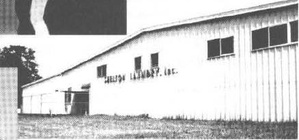The Shelton Laundry Building, (1934-1986) (now Bush Brothers), was located at 1111 Eads, Urbana.
After the stock market crash of 1929, many families found themselves in dire financial crisis. Seeking a means of support for her family, Arah Mae Shelton started bringing in laundry to her home. Beginning with a cast iron kettle and scrub board, she did the washings on the back porch. From this humble beginning in 1934, the Shelton Laundry grew to a state of the art business spanning more than five decades.
Detailed history
From a humble beginning in 1934, the Shelton Laundry grew to a state of the art business spanning more than five decades. Frances Shelton Moreland tells the story: "I was six months old when my parents, Arah Mae and Merritt Shelton moved to Champaign in 1923 from Covington, Tennessee. In Tennessee, they were farmers. In Champaign. Pop Shelton worked for the Illinois Central Railroad. Our first home in Champaign was in an area called 'Happy Hollow: near the railroad tracks. From there we moved to Poplar Street (now called Phillips Drive) and from there we moved to 1206 West Eads Street in Urbana where the laundry actually started in the backyard and later in the basement. I had three sisters: Ethel Mae Shelton-Jones, Mary Shelton-Jones (both deceased), Martha Freeman and two brothers, Merritt. Jr. and Albert (deceased).
"When the 'crash' of 1929 occurred many families found themselves in dire financial crisis, and through the government subsidies offered, we would stand in line at a local site (a church at 5th and Vine) to receive our share of milk and other commodities. Because of disputes as to who was first in line, my mother felt that there must be a better way than this to help support our family, so she decided to start taking in washings, in addition to doing laundry in the homes of families. Since there was no form of public transportation at that time, she had to walk great distances to and from those homes, so in 1934, she started bringing washings to our horne. It was our (the children's) job to pick up and deliver the laundry, using an old-fashioned laundry basket with two handles. Our first family to do laundry for was Mrs. Morgan who lived on South State Street in Champaign. We graduated from a two-handled basket to a wagon to put the basket on to pick up and deliver. In the summer. Mother would do the washings on the back porch using the scrub board. The water was heated in a large black iron pot which her father sent to her from Tennessee. She would heat the water by placing the large black pot on bricks and building a fire under it. In the winter, the water was heated on top of the coal stove lind the washings were done in the kitchen as we had no basement to the house at that time. We used the old-fashioned flat irons that were heated on top of the stove to do the ironing, then we graduated to an iron that used kerosene and a pump to heat. Later on when we had electricity in the house, we were able to have electric irons and could do better work with the American Beauty Irons that weighed about 5 pounds. As income increased, Mother was able to have a basement dug and finished so we moved our laundry operations to the basement. We hung lines to dry clothes and did the ironing there. Mother had a dear friend named Carrie Burks who joined us, so we left 1206 West Eads and wcnt to a vacant house on the corner of 6th and Vine Street" where they would do the laundry, This arrangement did not prove satisfactory to Mother so we went back to the basement at 1206 West Eads, Needing more space, we moved to 1408 West Eads where there was an old garage building which she converted into a laundry.
"She and my youngest brother Albert would go to Chicago to negotiate with dealer and purchase machinery. We had a wooden washer that was motor driven and mangles to sit down to use and hand irons. At that time, we were doing work for fraternities and sororities, plus McKinley Hospital and the IIIini Union. In 1950. we had a terrihle fire which destroyed the garage, but with the help of the insurance settlement were able
to put up a cement block building. We had two more fires in 1953 & 54 but by it being built of block, the damage was confined to the ceiling and Mother rebuilt and we continued our busines there until around 1965.
Read the rest of this story at eBlackCU:
Through the Years, African American History in Champaign County, Spring/Summer 2000 - Read online at eBlackCU: http://eblackcu.net/portal/items/show/54



